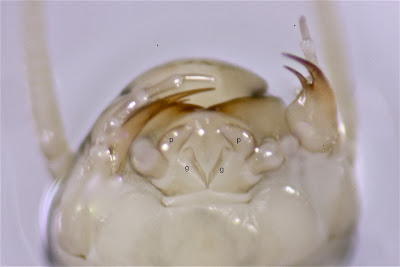In terms of "Functional Feeding Groups" (FFG's), stoneflies fall into two different groups: predators = common stoneflies (Perlids), Perlodids, and green stoneflies (Chloroperlids); and herbivores/detritivores = giants, roach-likes, large winters, small winters, rolled-wingeds, and Nemourids. Directly related to this, predators have one kind of labium (lower lip), herbivores have another.
Is this important information? Well, I doubt that this would be a Jeopardy question (!), but it is something you do have to know if you work in a macroinvertebrate lab. When this came up for me when I worked with StreamWatch was normally in the fall when we would often have very small stoneflies that needed identification. Wingpads are not yet developed on immature stoneflies, and almost all tiny stoneflies are tan or yellow -- sometimes almost transparent in color. The most common decision that we had to make was: is this a green stonefly? a large winter stonefly? a small winter stonefly? or a Perlodid stonefly? These four families can be confused when they're small. Sometimes, "common" stoneflies could also cause problems -- but they usually couldn't hide their "hairy armpits".
What did we do? We looked at their lower lips (labia). So let's do that, first for the "predator" group (Perlids, Perlodids, Chloroperlids), and then for the "herbivore" lot (here, just the large and small winters). The head at the top of this page is that of a Perlid (common) stonefly, genus Acroneuria. Let's flip that head over.
The four elements at the top of the labium are the paraglossae (p,p -- upper distal margins of the labium) and the glossae (g,g -- lower distal margins of the labium). With all predators, the paraglossa is on top of the glossa, and inbetween the glossae, there is a notch, a "V". The stems branching out from the base of the glossae are the "labial palps".
Perlodid. The labial "notch" in the Perlodid stonefly is even more pronounced. Let's have a look.
Again the paraglossae (p,p) rise over the glossae (g,g), but here the glossae lean back, forming a very clear "V" -- i.e. a "notch".
Chloroperlid (Green).
Mature Perlodid stoneflies and mature Green stoneflies look quite a bit different: the wingpad shapes in both cases are distinct, and you may recall that the tails of the Green stonefly are abnormally short. But,
if we have to decide between Perlodid and Green based on this look at their labia -- their paraglossae and glossae -- we're in big trouble! So what do we do? At this point we crank up the microscope magnification and draw down on the last two segments of the maxillary palp. Here you go:
I've written "mp" on the next to last segment of the maxillary palp of this Green stonefly. The final segment is visible -- but just barely (that's an arrow that points to it). On the Perlodid stonefly, the final segment would not be this thin. I.e. on a Perlodid stonefly the final segment is almost as thick as the preceding segment; on a Green stonefly it's dramatically thinner.
The critical thing for us to note is the shape and location of the glossae and paraglossae in the labium of a predaceous stonefly, and how a "notch" is formed between them. On to the large and small winters.
Large Winter (Taeniopterygidae).
Notice how this labium differs from the labia of the predator group. First, the paraglossae and glossae are lined up together -- side-by side -- and roughly equal is size and shape: and second, there is no "V" formed between the glossae, no "notch".
Small Winter (Capniidae).
A little more difficult to see -- but the configuration on the small winter is the same as we find on the large winter. No "V"; no "notch". To move on and distinguish the small winter from the large winter, you have to look at the abdomen: the small winter abdomen has "venterolateral folds" (see the entry for 12/19/10 ).
I realize that most volunteers monitors will not be in situations where they have to make these kinds of decisions. Still, it's always of interest to see what goes on in the lab with tricky cases of identification.
(Below, "dorsal" views of the stoneflies we have just looked at.)
Perlid (common):
Perlodid:
Chloroperlid (green):
Large Winter (Taeniopterygidae) -- mature and "tiny":
Small Winter (Capniidae):












No comments:
Post a Comment